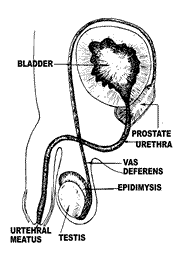| CROSS SECTIONOF THE MALE GENITALIA |
 |
Why?
The urethra is lined with very delicate and highly sensitive skin and just before entering the bladder, passes straight through the prostate gland. So the act of inserting a catheter or sound into the urethra, when performed gently and with great care, is capable of producing the most intense and pleasurable of sensations.
At a base level, we have found another hole to fuck!
Psychologically, urethral insertion is both an act of trust and submission. Submission, in that a very intimate area of the body is being invaded and control of a very private and personal body function is being relinquished. Trust, because of the risk of serious injury if it is not done properly.
What to use
The only things that should be inserted into the urethra should be things that have been designed expressly for that purpose. This basically means 3 things, urinary catheters, urethral / vaginal dilators and sounds, and Prince’s wands.
Items to be inserted must be STERILE.
| COMMON CATHETERS | ||
 |
Catheters
A Catheter is simply a narrow rubber tube that has a rounded end for insertion and an open end for drainage. This is slid up the urethra, in to the bladder. Foley catheters are slightly different in that they have a second tube or lumen within the first, with which a retaining balloon can be inflated. Thus anchoring the catheter semi-permanently.
[Back to top]
Sounds/Dilators
A variety of sounds and dilators are manufactured to stretch the urethra.
These are usually made from surgical steel and include straight sounds, tapered sounds for stretching and Van-Buren sounds which have a 90° bend at the end.
In addition the smaller sizes of dilators designed for vaginal use, which have a gentle S shape to them can also be used.
Prince’s Wand
A Prince’s Wand is a drilled steel tube which can be inserted into the urethra and anchored there through genital piercings in the head of the penis.
Clean or sterile?
Invasive procedures in hospital are performed as sterile procedures. This is not practical in the home/play environment, but the procedure must still be performed under extremely clean conditions.
Items to be inserted must be sterile. Catheters can be purchased pre-sterile. Sounds, dilators and wands can be sterilised at home. Autoclaves are expensive and not every home has one, so the next best thing is a pressure cooker, 15 lbs pressure for about 30 minutes.
Alternatively, soak in dilute hydrogen peroxide for a couple of hours then rinse and boil in a saucepan for about 15 minutes.
Preparation
Invasive procedures should be performed under meticulously clean conditions, using sterilised equipment. Hands should be washed thoroughly with hot soapy water, and the tip of the penis should be cleaned with soap and water or a non irritating antiseptic solution such as Betadine.
[Back to top]
Catheter insertion
To insert a catheter, the penis is first raised to a right angle to the body, or even slightly higher.
The catheter and the opening in the penis should be copiously lubricated with a sterile water soluble lubricant such as K-Y. Touch the catheter as little as possible. The catheter should be gently guided in to the opening in the end of the penis. It should go in between 6 to 12 inches before resistance is encountered.
Apply a little firm, but gentle pressure, which should result in a flow of urine.
| FRENCH SCALE OF TUBE/CATHETER DIMENSIONS |
 |
Foley catheters
Advance the catheter about 2 to 3 inches further before inflating the catheter balloon. Use a syringe containing the correct volume of sterile water, via the balloon port of the catheter. The balloon port will have the volume printed on it, usually 5 to 10 mls.
The port contains a self sealing valve which will close when the syringe is removed from it. The catheter is now secure and can not be removed without deflating the balloon.
Catheter removal
Using a syringe remove, via the catheter balloon port, the same quantity of water as was inserted. Draw the catheter slowly and smoothly out of the penis.
Sound insertion
The sound and the opening in the penis should be copiously lubricated with a sterile water soluble lubricant such as K-Y. Touch the sound as little as possible.
The sound should be gently guided in to the opening in the end of the penis, and allowed to slide in under it’s own weight. Support the sound and guide it gently as it slides in. Do not let go of the sound, it is heavy and will act like a lever, which could cause internal injury.
[Back to top]
Van Buren sounds
Van Buren sounds have a 90° curve at the tip, this means that the penis must be soft during insertion and removal. The sound must be inserted perpendicular to the plane of the body, with the curve pointing down in to the penis and the handle above the stomach.
What you need
1. Pre-Sterile sound/catheter/wand.
2. Pre-Sterile water based lubricant (K-Y).
What might be useful?
1. Pre-Sterile catheter pack.
2. Pre-Sterile surgical or medical procedure gloves.
3. Something to collect urine in i.e. catheter bag.
4. Catheter clamp or spigot.
Things to remember!
Be very, very gentle. NEVER USE FORCE. Movement of objects within the urethra should be kept to a minimum to avoid trauma.
Urethral insertion is NOT PAIN PLAY. Any pain whatsoever STOP immediately. Try again another day.
The entire procedure must be EXTREMELY CLEAN. So don’t mix invasive procedures with any ‘dirty’ play.
It is both painful and very dangerous to leave a catheter clamped for long periods. If the bottom complains of more than slight discomfort due to a full bladder, that is the time to think about releasing the clamp. It is not advisable to leave a catheter in place too long, apart from the risk of infection, the bladder and sphincters can loose muscle tone quite rapidly.
What should you do in an emergency?
After a urethral insertion scene, it is usual for there to be a burning sensation when you urinate. This may last up to 48 hours. If there is blood or pain after urethral insertions, medical advice should be sought; also, if the bottom has not urinated within 12 hours.
If you think you have done some major damage, get the bottom to your nearest A & E department as soon as possible or dial 999.
